Hand washing at home and school is very important for staying healthy because it prevents the spreading of germs. Kids, especially, need to aim to keep their hands clean for as long as possible. This blog will outline the importance of washing hands, give effective steps, share best practices to teach kids, and highlight common mistakes to avoid. Ready to wash those hands and make it fun? Let’s get cleaning!
Enrol our Early Childhood Development Course course from Jobsland.
Importance Steps for Wash Hands Properly
Hand washing is crucial for preventing illness as it effectively removes germs that can cause infections and diseases. By washing hands properly and frequently, especially before eating, after using the toilet, or after coughing/sneezing, individuals can significantly reduce the spread of harmful bacteria and viruses.
Explanation of How Germs Spread
Germs are small, microscopic organisms that cause illnesses. They can be spread through direct contact with someone who is already infected, contaminated objects or surfaces, or simply by touching our faces, eating, or putting our hands or other objects in our mouths when they are dirty.
Role of Hand Washing in Preventing Illness
Hand washing has proven to be one of the most effective health practices to stop the spread of germs. Washing your hands helps to prevent infections by removing dirt, viruses, and bacteria from your hands, thereby reducing the chance of colds and other infections.
Building Healthy Habits for Hand Washing
Teaching kids about Hygiene. If children are taught from a young age about the importance of hygiene (‘Washing your hands will prevent you from getting sick and also stop the spread of germs everywhere’), the habit is more likely to become ingrained.
Long-Term Benefits of Wash Hands Properly
Constant hand washing teaches children to stick to a routine that will protect them from sickness throughout adulthood, reducing the likelihood of falling ill and missing school — and missing out on experiences.
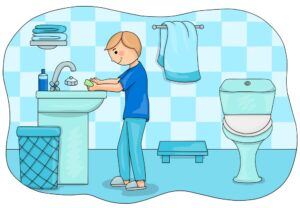
Contribution to Overall Community Health
Supporting the public is also important. When you wash your hands properly, not only do you prevent yourself from passing on germs, but you also help to stop the spread of illness within your community. If all the children wash their hands properly, then the risk of outbreaks will be considerably reduced, and everyone can stay healthy.
Importance in Schools and Public Places
Schools and public places are where many people spend their time because they have lots of visitors and shared surfaces. People cannot avoid picking up germs while visiting these places, so it becomes really important to teach children to wash their hands in public restrooms, or after/between school activities, to protect the public.
Ensure Kids Wash Hands at these crucial times
Kids should consistently wash their hands before and after eating to maintain good hygiene. Washing before eating removes any dirt or germs that could transfer to their food, preventing illnesses. After eating, washing their hands removes any leftover food particles and reduces the risk of spreading germs to others or touching their faces with contaminated hands.
Explanation of Washing Hands Before Eating
It’s crucial to wash your hands before eating to remove dirt and germs accumulated throughout the day. This simple act helps ensure that children don’t transfer these contaminants to their food, promoting cleaner and healthier eating habits.
Importance of Washing Hands After Eating
It’s essential to wash hands after eating, especially when food is consumed by hand. This practice effectively removes food particles and grease, which can attract germs. By washing hands after eating, you prevent the spread of germs to other surfaces or individuals, promoting a cleaner and healthier environment.
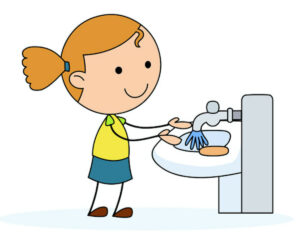
Emphasising the Need to Wash Hands After Using Toilet
When children use toilets, they inevitably come into contact with bacteria. If they neglect to wash their hands afterward, these bacteria can easily spread. Therefore, it’s crucial to wash hands thoroughly after using the toilet to effectively remove these germs and reduce the risk of illness.
Wash hands After Playing Outside or with Pets
Playing outside and interacting with pets exposes children to germs and dirt. Washing hands after these activities helps remove harmful substances and keeps children safe.
Wash Hands to Prevent the Spread of Germs
When a sick child coughs, sneezes, or blows their nose, respiratory droplets containing germs can spread throughout the house. Washing hands after these activities prevents germs from spreading to objects like cups and phones, as well as to other children in the household or neighbourhood.
Wash Hands in these Additional Situations
After handling rubbish, visiting someone who is unwell, or coming into contact with animals or their faeces, it is important to wash hands thoroughly. These activities can expose children to germs that could cause illness. Washing hands effectively removes these germs, reducing the risk of spreading infection and keeping children healthy.
Check out our Childhood Development Essentials course on Jobsland.
6 Steps for Proper Wash Hands Properly
Proper hand washing involves six essential steps to effectively remove dirt, bacteria, and viruses. Begin by wetting your hands with clean, running water and applying enough soap to cover all surfaces. Lather vigorously, ensuring to scrub the backs of your hands, between fingers, and under nails for at least 20 seconds. Rinse thoroughly under clean, running water to remove soap and loosened dirt, then dry with a clean towel or air dry. Use a towel to turn off the tap to prevent re-contamination. Consistently following these steps ensures clean hands and reduces the spread of germs and infections.
Step 1: Importance of Wet Hands with Clean, Running Water
Having clean, running water to wet your hands is crucial for effective hand washing. It helps to remove dirt and germs from your hands before you apply soap, ensuring a thorough cleaning process that promotes good hygiene and reduces the spread of illness.
Importance of Using Clean Water
Running water is significantly more effective for cleaning hands than standing water, which may be contaminated. Hundreds of thousands of water droplets in running water help to thoroughly cleanse hands by rinsing away dirt and germs effectively.
Avoiding Standing Water
Conversely, standing water can harbor bacteria and other pathogens, making it less safe for hand washing. Always choose a faucet or tap with running water to ensure proper hygiene and minimize the risk of spreading germs.
Step 2: Importance of Apply Soap to Wash Hands
Applying soap when washing hands is essential because it helps to break down and remove dirt, oils, and germs more effectively than water alone. Soap creates a lather that covers all surfaces of the hands, including hard-to-reach areas like between fingers and under nails, ensuring a thorough cleansing process. This step is critical for reducing the risk of infections and promoting overall hand hygiene.

Types of Soap to Use
Whether you prefer bar soap, liquid soap, or foam, the type doesn’t make a significant difference in cleaning effectiveness. Antibacterial soap is unnecessary; regular soap is just as effective when used correctly. Focus on thorough hand washing with any type of soap to effectively remove dirt and germs, promoting proper hygiene without the need for antibacterial additives.
Ensuring Enough Soap is Used
You will know you have applied enough soap when air bubbles dance across all parts of your hands, ensuring thorough coverage rather than just one area. This indicates sufficient soap to effectively cleanse your hands and remove dirt and germs.
Step 3: Role of Lathering in Effective Hand Washing
Lathering during hand washing is crucial as it helps to mechanically remove dirt, grease, and germs from the skin. By creating friction and spreading soap across all hand surfaces, lathering ensures thorough cleansing that water alone cannot achieve. This step is essential for effective hand hygiene and preventing the transmission of infections.
Importance of Creating a Good Lather
Lathering is crucial in hand washing as it effectively lifts dirt, grease, and germs from the skin, contributing significantly to their mechanical removal. This step is essential for achieving thorough cleanliness and reducing the spread of infections.
Areas to Focus On: Back of Hands, Between Fingers, Under Nails
Pay particular attention to cleaning every part of your fingers, the backs of your hands, between your fingers, and underneath your nails. These areas accumulate the most germs and require thorough cleaning to prevent the spread of infections.
Step 4: Importance of Scrub Hands for 20 Seconds
Scrubbing hands for at least 20 seconds is crucial because it allows enough time for soap to effectively lift dirt, grease, and germs from the skin. This thorough scrubbing helps ensure that hands are properly cleaned and reduces the risk of spreading infections. It’s a simple yet effective measure in maintaining good hand hygiene and promoting overall health.
Fun Ways to Time It (Singing Songs, Counting)
Scrubbing your hand properly in important.. Ensure you scrub your hands for at least 20 seconds, which is roughly the time it takes to sing ‘Happy Birthday’ twice, or count to 20 slowly. Parents should encourage their children to adopt this habit at home, so they continue to practice it wherever they go. This helps in effectively removing dirt and germs, keeping hands clean and reducing the risk of infections.
Ensuring Thorough Scrubbing
Scrub all surfaces of the hands thoroughly, including thumbs, palms, backs of hands, between fingers, and under nails. Remind children that a proper scrub involves cleaning all sides of the nails and should take enough time to ensure thorough cleaning. This helps remove dirt and germs effectively, promoting good hand hygiene and reducing the spread of infections.
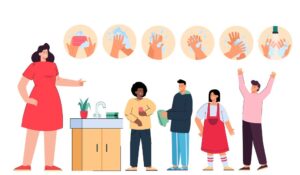
Step 5: Importance of Rinse Hands With Clean, Running Water
Rinsing hands with clean, running water after washing is crucial to remove soap and any loosened dirt, grease, or germs. This step ensures that hands are thoroughly cleaned and prevents potential irritation from residual soap. Using running water helps wash away contaminants effectively, maintaining hygiene and reducing the risk of spreading germs.
Ensuring All Soap is Rinsed Off
Wash hands under clean, running water to completely rinse away soap and loosened germs. Residual soap left on the skin not only has the potential to irritate but also may leave behind germs that were not fully removed during washing. Thorough rinsing ensures that hands are clean and free from any remaining contaminants, promoting effective hand hygiene.
Use of Clean Water for Rinsing
Use running water to ensure thorough rinsing and complete removal of all contaminants. Standing water can reintroduce germs, making it crucial to rinse with running water to effectively cleanse your hands.
Step 6: Role of Dry Hands Using a Clean Towel or Air Dry
Drying your hands thoroughly using a clean towel or allowing them to air dry is essential to complete the hand washing process. This step helps remove any remaining moisture that could harbor germs and also prevents the spread of bacteria that thrive in damp environments. Whether using a towel or air drying, ensuring hands are completely dry minimizes the risk of transferring germs to surfaces or objects touched afterward.
Importance of Drying Hands Properly
Ensuring hands are completely dry before leaving a restroom is crucial for hygiene and skin health. Wet hands can spread germs and lead to irritation, especially in colder weather. Drying thoroughly with a clean towel or air drying helps prevent germ transmission and protects against dry, chapped skin.
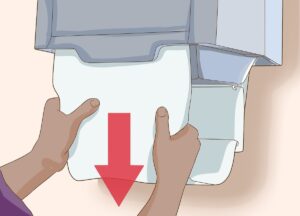
Types of Towels to Use (Paper, Cloth, Air Dryers)
- Paper Towels: To effectively dry your hands and eliminate germs, use disposable paper towels. After use, promptly discard the towel to prevent germ transfer and maintain cleanliness.
- Cloth Towels: Use clean cloth towels or disposable paper towels for drying hands, and make sure to change cloth towels regularly to prevent the accumulation of germs. It’s advisable to avoid using shared towels in public restrooms to minimize the risk of spreading infections.
- Air Dryers: Avoid using air dryers in public washrooms due to concerns about potential energy wastage and the spread of germs. Ensure your hands are completely dry before leaving to prevent contaminating surfaces and controls.
Tips for Teaching Kids to Wash Hands Properly
Teaching kids proper hand washing is crucial for hygiene. Lead by example, make it fun with games or songs, and explain its importance. Use visual aids, supervise initially, and ensure accessibility. Encourage regular washing before meals, after using the toilet, and after outdoor play to instill lifelong habits.
Making it fun Using Songs and Games
Sing a familiar song like “Happy Birthday” twice through, or use fun apps that play tunes while they wash. Turn it into a race against the timer or a game where they pretend to paint their fingers until they’re completely clean. This makes hand washing enjoyable and encourages thoroughness.
Creating a Hand Wash Chart or Reward System
Display a hand washing chart on the wall and use stickers to mark each wash. Offer small rewards when children reach a certain number of days with consistent hand washing. Rewarding good behaviour is an effective method to encourage and reinforce healthy habits.
Showing Proper Hand Wash Steps with Examples
Children often learn by watching adults. Show them how to wash hands properly by demonstrating the steps—lathering, scrubbing, and rinsing—each time you do it yourself. Modeling this behaviour increases the likelihood that your child will adopt it too.
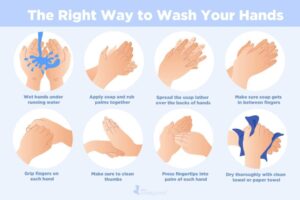
Consistently in Hand Wash Practice
Consistency plays a crucial role. Demonstrating proper hand washing consistently in front of your children and inviting them to participate reinforces the habit in their daily routines. As a parent, setting a strong example like this can be very influential.
Using Visual Aids for Hand Wash
Posters and videos serve as effective visual aids for teaching proper hand washing. Display posters outlining the steps in toilets and kitchens to reinforce learning visually. Additionally, show instructional videos from reputable health websites to inform and engage viewers simultaneously.
Step-by-Step Hand Wash Guides with Pictures
Encourage children to consistently follow hand washing steps by creating step-by-step drawings on paper for their reference. Place these visuals on the wall or near the sink as reminders. These visual cues help children associate the steps visually with the actual process of washing hands, making it easier for them to remember and follow the correct procedure independently.
Adding Hand Wash into Daily Routines
To make sure the habit sticks, include hand washing in daily routines: before meals, after using the bathroom, and after playing outside. This regular practice helps children remember to keep their hands clean.
Encouraging Hand Wash Habit Regularly
Consistently encourage proper handwashing each time you see it. Praise the child, pointing out what they did well, and sometimes mention what could be improved. This regular encouragement helps the habit stick.
Hand Wash Common Mistakes and How to Avoid Them
To effectively wash hands, it’s crucial to avoid common mistakes. First, ensure you wash for at least 20 seconds to thoroughly clean all surfaces, including the backs of hands, between fingers, and under nails. Use comfortably warm water instead of cold to remove dirt effectively. Rinse hands under clean, running water until all soap residue is gone, and dry them completely with a clean towel to prevent germ spread. Choose moisturizing soaps to avoid drying out your skin and apply hand cream as needed. These steps help maintain good hand hygiene and reduce the transmission of germs effectively.
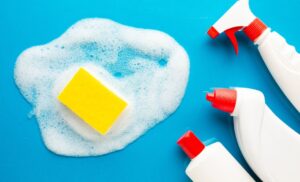
Emphasising the 20-Second Rule
Teach your children to wash their hands thoroughly for at least 20 seconds. Encourage them to scrub all parts of their hands, including their fingertips, using a timer, singing a song, or counting to ensure they wash for the recommended duration. This helps in effectively removing germs and maintaining good hand hygiene.
Using Timers or Songs to Help
Use fun methods like singing “Twinkle, Twinkle, Little Star” or using a kitchen timer to time hand washing. Introducing characters like Hello Kitty can make the activity enjoyable and help children stay engaged while they wash their hands. These playful tools not only make hand washing more fun but also ensure they wash for the right amount of time to remove germs effectively.
Reminding Kids to Wash Between Fingers and Under Nails
Remind kids daily to scrub all parts of their hands thoroughly. Show them where germs hide by sprinkling glitter under their nails. This visual aid helps them understand the importance of cleaning every area of their hands to stay healthy.
Teaching Techniques for Wash Hands
Show children the correct areas to wash, focusing on commonly overlooked spots. Practice together so they grasp the steps, then encourage them to wash their hands independently, reinforcing good habits.
Benefits of Warm Water to Wash Hands
Explain to children that using warm water helps soap to create more lather and effectively removes germs compared to cold water. Emphasize that warm water is gentle on their skin and ensures thorough cleaning without being too hot.
Importance of Soap to Wash Hands
Teach children that using soap when washing hands is crucial because it helps to kill germs and remove them effectively. Ensure they understand the importance of using soap for thorough hand cleaning and preventing the spread of germs.
Ensuring Soap for washing hands
Ensure soap dispensers are always full and accessible in convenient locations. Keep extra supplies nearby so children never face the excuse of running out of soap. This practice not only promotes good hygiene but also instills valuable life skills.
Alternatives Elements For Wash Hands Properly
Hand sanitizers should be used when soap and water are unavailable, such as during travel or in crowded places. Dispense enough sanitizer to cover all hand surfaces, including between fingers and under nails, and rub hands until dry, about 20 seconds. Teach children not to touch their face with unwashed hands to prevent germs from entering their body. Encourage using tissues or elbows to cover coughs and sneezes to reduce spreading germs to others. These practices help maintain good hygiene and reduce the transmission of illnesses.

Using Hand Sanitisers to Wash Hands
Use hand sanitizers when soap and water are unavailable, such as during travel, after touching public surfaces, or in crowded places where immediate access to a sink is not possible. This helps to effectively disinfect hands and reduce the risk of spreading germs.
Correct Use of Hand Sanitizers to Wash Hands
Dispense enough hand sanitizer into your palms to cover all surfaces of your hands. Rub your hands together thoroughly, ensuring to cover areas between fingers and under nails, until the sanitizer evaporates, which usually takes about 20 seconds. Show children the correct way to use hand sanitizer, emphasizing the importance of rubbing until their hands are completely dry. This ensures effective disinfection against germs.
Avoiding Touching Face with Unwashed Hands
Educate your children to avoid touching their eyes, nose, and mouth with unwashed hands to prevent germs from entering their bodies.
Learn more about Fundamentals of Child Care
Educational Resources and Activities for Wash Hands Properly
Various educational resources and activities, including children’s books like “Germs Are Not for Sharing” and “Wash Your Hands!”, interactive apps such as “Wash Your Hands with Baby Shark,” and online games from PBS Kids and Sesame Street, teach children about hand washing. Schools and community programs also play a crucial role in promoting hygiene through workshops and initiatives like Global Handwashing Day. These efforts aim to instill good hygiene habits in children in engaging ways.
Recommended Children’s Books About Hand Washing
They feature books by Elizabeth Verdick, such as “Germs Are Not for Sharing” (2007), which uses characters like Pizza and Cold Fizzy Belches to convey hygiene messages. Also included is Tony Ross’s “Wash Your Hands!” (2009), emphasizing the importance of hand hygiene in a child-friendly manner.
Using Storytelling to Teach Hygiene
Another effective method for teaching hygiene is through storytelling. Children can be encouraged to write or choose stories where characters demonstrate good handwashing practices and explain its importance. The moral of these stories helps children grasp that practicing good hygiene keeps bathrooms clean, enhances health, and protects family members.
Complete our Fundamentals of Child Psychology course to elevate your skill.
Using Apps That Teach Hand Washing
Mindless songs and games are not effective in making hand washing engaging and sustainable. Instead, apps like “Wash Your Hands with Baby Shark” and “Daniel Tiger’s Stop & Go Potty” offer songs and interactive games that reward children for washing their hands thoroughly for the recommended 20 seconds. These apps use catchy tunes and beloved cartoon characters to make hygiene habits enjoyable and memorable. Conversely, apps that don’t focus on hygiene, like “Poop Log,” are not beneficial and can waste valuable time without reinforcing important lessons about cleanliness.

Online Games and Activities that Teach Hand Washing
Websites like PBS Kids and Sesame Street provide online games that specifically teach children about hand washing and hygiene. These interactive platforms blend educational content with entertainment, effectively reinforcing healthy habits among young learners.
Community Programs That Promote Hand Washing
Many schools and community organisations host hygiene-focused hand-washing programmes. These initiatives often include presentations, workshops, and interactive games designed to educate children about the importance of maintaining good hygiene practices for their well-being.
Involvement in School Initiatives and Public Health Campaigns
Engage in school programmes or public health initiatives that promote hygienic behaviour to reinforce awareness among students. Global Handwashing Day, a worldwide hygiene initiative, employs classroom activities to advocate for hand washing and its role in enhancing public health globally.
Take our 6-1 Bundle on Alternative Medicine Resources.
Conclusion
Doing laundry effectively contributes to illness prevention, but ensuring children have spare underwear and receiving proper education are crucial for establishing lasting, healthy habits. Teach these steps consistently and review them with children to ensure they can perform them independently. Share your comments and experiences in the comment box below to contribute to the discussion. With community effort, we can ensure our children stay healthy and safe!
